#gulf of mexico whale
Explore tagged Tumblr posts
Text



The Very Nice Rice's Whale
Rice's whale, also known as the Gulf of Mexico whale (Balaenoptera ricei) is a species of whale found only in the Gulf of Mexico. Originally the species was thought to be restricted to the northeastern part of the gulf, but it is now known to travel throughout the area. They keep close to the coast, and are rarely seen in waters deeper than 400 m (1300 ft). Originally, Rice's whale was considered a subspecies of Bryde's whale (B. edeni), but in 2021 genetic testing revealed it to be a completely separate species.
Gulf of Mexico whales are moderately sized; females grow to 12.65 meters (41.5 ft) in length and 13.87 metric tons (15.28 US tons), while males are slightly smaller at 11.26 meters (36.9 ft) long. Adults are plain grey and three long ridges on the top of their heads, which makes up a full quarter of their body length. The throat pouches and the underside of the tail are pink.
B. ricei follows a diel vertical diving pattern; they spend the day foraging near the bottom of the ocean, and rise to the surface at night. Though little is known about the diet of Rice's whales, it is suspected that they feed on lanternfish, hatchetfish, and silver-rag driftfish, which are abundant at great depths. Because they are baleen whales, they likely ingest large quantities of water and then filter their catch through their baleen plates.
The breeding habits of Gulf of Mexico have not been studied, but scientists extrapolating from information on the closely related Bryde's whale believe that B. ricei reproduce once every two or three years. Pregnancies may last 10-12 months, and subsequent nursing may last for up to 2 years. Scientists also estimate that Rice's whale reaches sexual maturity at 9 years old, and can breed year-round due to the warm, food-rich waters in which they live. Adults are often seen in small groups of 2-4.
Conservation status: The Gulf of Mexico whale is considered Critically Endangered by the IUCN. Less than 100 individuals exist in the wild; most scientists estimate the population to be no greater than 33. Their primary threats are boat strikes and the hazards included in drilling for oil, including underwater noise and oil spills.
Photos
National Marine Fisheries Service
NOAA Fishieries
#rice's whale#gulf of mexico whale#Artiodactyla#Balaenopteridae#baleen whales#rorquals#whales#cetaceans#even toed ungulates#ungulates#mammals#marine fauna#marine mammals#open ocean#open ocean mammals#pelagic fauna#pelagic mammals#atlantic ocean#gulf of mexico#animal facts#biology#zoology#ecology
111 notes
·
View notes
Text
"It's called rain, comes down from comes down from heaven. And they want to do, no water comes out of the shower. It goes drip, drip, drip. So what happens you're in the shower 10 times as long, you know. No water comes out of the faucet."
-- Exact transcript of President-elect Donald Trump complaining about shower heads with restricted water flow during a batshit crazy press conference at Mar-a-Lago, January 7, 2024.
President-elect Trump, who also pointed out during the press conference that "The windmills are driving the whales crazy", touched upon some more serious matters, as well, implying that the United States may take back control of the Panama Canal by force, potentially use force and/or economic coercion to force Denmark to sell Greenland to the United States (he will "tariff Denmark at a very high level" if they don't give us Greenland), and continued to suggest that Canada should become an American state. Oh, he also talked about changing the name of the Gulf of Mexico to the "Gulf of America" because he's an asshole.
In case you forgot, over 77 million Americans -- including, undoubtedly, people you love and who say they love and care about you -- voted for this person to lead our country for the next four years, despite...well...despite fucking everything we have experienced since 2015.
I seriously don't know if I can do this again for another four years.
#ELECTIONS HAVE CONSEQUENCES#THESE ARE THE CONSEQUENCES#I THOUGHT WE LEARNED THIS GODDAMN LESSON LAST TIME#Donald Trump#President Trump#Trump Administration#President-elect Trump#Presidency#Politics#2024 Election#Presidential Election#Greenland#Denmark#Gulf of Mexico#Canada#Panama Canal#Panama#Trump Press Conference#Presidential Politics#President-elect#Shower Head#Windmills#Windmills vs. Whales
214 notes
·
View notes
Text

Eastern Tropical Pacific killer whale Orcinus orca
Observed by azure27014, CC BY-NC
#Orcinus orca#Eastern Tropical Pacific killer whale#Cetacea#Delphinidae#cetacean#dolphin#whale#North America#Mexico#Baja California Sur#Pacific Ocean#Gulf of California#underwater
182 notes
·
View notes
Text
"Mexico’s government recently announced the creation of 20 new protected areas across 12 states and two coastal areas in the country, covering roughly 2.3 million hectares (5.7 million acres). This follows a series of budget cuts to the nation’s environmental agencies.
Officials introduced four new national parks, four “flora and fauna protection areas,” seven sanctuaries, two biosphere reserves and three “natural resources protection areas” under the protection of the National Commission of Protected Natural Areas (CONANP).
“This is a commendable step toward biodiversity conservation and environmental protection,” said Gina Chacón, director of the Wildland Network’s public policy program in Mexico. She told Mongabay these new areas will help preserve the country’s rich ecosystems, foster sustainable practices and protect a broad range of important species and habitats. Though some environmental and Indigenous groups are wary the budget cuts could hinder efforts to conserve these areas.
The newly protected areas will preserve habitat and ecologically important marine areas for various species, including whale sharks (Rhincodon typus), Mexican prairie dogs (Cynomys mexicanus) and jaguars (Panthera onca). They will also help safeguard ecologically important coral reefs and areas of cultural significance to Indigenous communities.
Bajos del Norte, a new national park in the Gulf of Mexico, is the largest new protected area, covering 1,304,114 hectares (3,222,535 acres), almost nine times the size of Mexico City. The area is important to the more than 3,000 families that belong to fishing communities on the Yucatán coast. It is also one of the main grouper fish (Epinephelinae) reproduction sites in the Gulf of Mexico and will safeguard threatened species, such as the rocky star coral (Orbicella annularis) and the hawksbill turtle (Eretmochelys imbricata).
Joaquín Núñez Medrano, the secretary of the UEFAHG or Union of Forestry and Agricultural Ejidos Hermenegildo Galeana A.C. (Unión de Ejidos Forestales y Agropecuarios Hermenegildo Galeana), lives in an ejido — a type of communally owned land used for agriculture and forestry purposes — called Cordòn Grande in Sierra Grande of Guerrero, along the Pacific Coast. For more than 10 years, Medrano’s community has monitored species such as the jaguar and sustainably managed the ejido’s natural resources, without government assistance.
But now, the ejido has been designated a protected area in this latest round of decrees, as it falls inside part of the new Sierra Tecuani reserve. “The goal is to strengthen what we have already been doing but with support to do it much better,” he told Mongabay.
The second- and third-largest newly protected areas are Sierra Tecuani, a 348,140-hectare (860,272-acre) biosphere reserve threatened by illegal logging, forest fires and land use changes, and the Semidesierto Zacatecas Flora and Fauna Protection Area, which is important for the recovery of the Mexican prairie dog.
The state of Oaxaca is where the government created the most new protected areas, numbering three: the 90-hectare (222-acre) Playa Morro Ayuta Sanctuary, the 56-hectare (138-acre) Barra de la Cruz-Playa Grande Sanctuary and the 261-hectare (645-acre) Playa Cahuitán Sanctuary. Other protected areas were created in the states of Quintana Roo, Veracruz, Campeche, Nayarit, Zacatecas, Chiapas, Colima, Durango, Jalisco, Chihuahua, Guerrero and the State of Mexico...
President Andrés Manuel López Obrador has protected more areas than any previous administration, with a total of 43 new areas across 3 million hectares (7.4 million acres). But Mexico’s Secretariat of Environment and Natural Resources (SEMARNAT), which works to safeguard the environment, has become severely cash-strapped throughout his six-year term.
SEMARNAT is one of many sectors in Mexico undergoing funding cuts. In recent years, Obrador’s government has implemented a series of strict austerity measures to free up more money for other areas like pensions and wages, boosting the leader’s popularity among citizens, particularly the working-class. Judicial workers, health services and academia have also had their budgets slashed in 2024...
Juan Bezaury-Creel, the director of the organization Fundación BD BioDiversidad Mexicana, said a protected area is better than no protected area because, once a decree is formalized, the government has a duty to protect it. However, this puts “huge pressure on existing personnel because they have to take care of more surface area with less resources,” he told Mongabay.
“The personnel from CONANP are heroic,” he said. “They are putting their lives on the line many times with little budget and little help.”"
-via Mongabay, January 25, 2024
#mexico#lopez obrador#andrés manuel lópez obrador#protected areas#environment#deforestation#environmental issues#national park#gulf of mexico#yucatán#oaxaca#endangered species#good news#hope#whale shark#prairie dog#jaguar
346 notes
·
View notes
Video
youtube
The Israel Hamas War Is Getting Worse By The Minute... Hostages, Misinformation, & What Happens Now
#youtube#hamas#Israel#Palestinians#Netanyahu#Mack Trucks#UAW#UAW strike#rice's whale#critically endangered species#Gulf of Mexico#Philip DeFranco
2 notes
·
View notes
Text
0 notes
Text
November 16, 2023 — NMNH after hours event with New Orleans, LA musician and composer Cory Diane (at right) and collaborators.
0 notes
Text
Fish of the Day
Today's fish of the day is the Giant isopod!
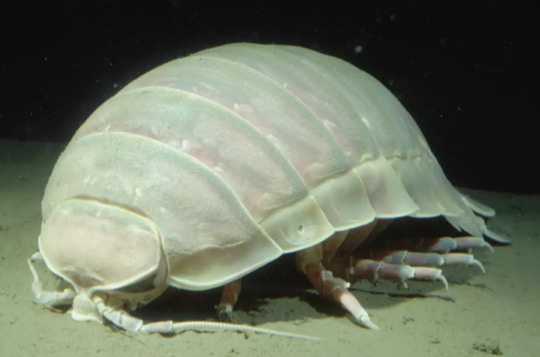
The giant isopod, describes around 20 species in the Bathynomus genus, but most information is based on the Bathynomus giganteus, which is known for being the first giant isopod discovered, and the largest. Giant isopods, as an arthropod, have seven pairs of legs, four jaws, and compound eyes that have over 4,000 facets. The first set of legs is modified into an appendage for grabbing food and bringing it into the mouth, along with attacking prey, and all species with the Bathynomus genus are similar, showing a lack of evolution between populations The full range of this family is unknown, but they can be found around the Indo-Pacific and the Eastern Atlantic ocean. The first time a giant isopod was found and recorded was in 1879 in the Gulf of Mexico, where the largest populations of giant isopods live, with a depth range of 310-2140 meters of depth. Outside of the Gulf of Mexico the other populations have a near identical depth range, and due to their similarity to their close land dwelling cousins, rolly pollies or woodlouse as you might know them, they are one of the textbook examples of deep sea gigantism.
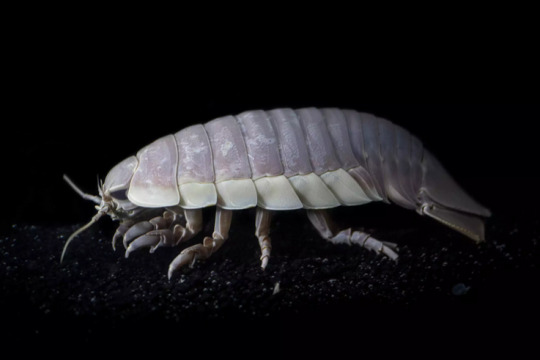
Deep sea gigantism is an observed phenomena where deep sea animals have a habit of getting far larger than their more shallow relatives. Examples of this would be the giant squid, giant sea spider, deepwater stingrays, the bigfin squid,oarfish, and many more. There is currently no encompassing explanation for why this phenomena is so prevalent, but there are multiple theories that have been proven partially correct by different genus. Food scarcity is often referenced, and often thought to be the reason for the giant isopods' large size. as without much food in the deep ocean organisms with the ability to store more food can live for longer periods without prey. Another explanation is the increase in dissolved oxygen, which is often a limiting factor in how large animals can become in their environments. A study of amphipod crustaceans in 1999 discovered their increase in size as the populations found in deeper waters directly increased with the amount of dissolved oxygen. The last and often most damning explanation for deep sea gigantism is the lowered temperature in deeper waters. This one can increase the size in animals by increasing cell size and lifespan, something that can also be found at the world's poles. Deep sea gigantism allows for the giant isopod to get anywhere between 19-36cm (7.5-14.3 inches) in length, with the largest recorded being 20 inches, about the size of a small dog. As compared to their close land relatives, which come in at less than an inch of length.
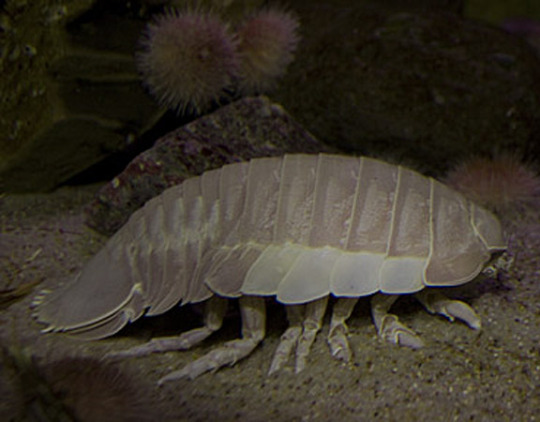
The diet of the deep sea isopod is remarkably similar to that of the land dwelling isopods, as the land dwelling isopods live off of dead or decomposing animals or plant materials. Which is similar to the diet of the giant isopod, which is an essential scavenger and carnivore in the deep. Once believed to be only scavengers, it is now known that giant isopods also actively pursue prey, usually fish, squid, shrimp, crabs, and other deep sea animals they can catch, as shown by a video of an isopod grabbing a dogfish shark and eating its face. These isopods can take down prey several times larger than them, but this may be only when in a confined space, as they don't swim fast and can only attack prey they can catch. But, as scavengers in the deep the giant isopod is primarily known for eating from whalefalls. A whalefall being when the carcass of a dead whale drifts to the deep seafloor, creating huge ecosystem hotspots and specialized animals in deep waters that feed almost exclusively on them. After eating from these whalefalls, giant isopods have been shown to go as long as 5 years in captivity without eating again, and for this reason when in the presence of food they eat far more than their body weight or size, willing to sacrifice locomotion in favor of excess, an easy trade considering they have no natural predators. Despite having no predators, they still have several behaviors similar to land pill bugs, as they can still roll into a ball shape, using their chitin armor to protect themselves, and burrow into the sediment to semi-hibernate.

The reproduction of the giant deep sea isopod is like that of many other arthropods, relying on eggs. In the spring and winter months the isopod females will begin brooding eggs, this is done in a pouch above the stomach and it will store anywhere between 20-30 eggs. During the brooding the female will burrow down into the sediment and refuses to leave until all eggs are hatched, at which point the juveniles are left. Captive isopods eggs measure 13mm in diameter and are thought to possibly be the largest marine invertebrate egg. Once born, these juvenile giant isopods will be as large as 4 inches in length ,and set off on their own in a stage called manca. At this stage, these are almost fully developed giant isopods, lacking only the last pair of legs. These will grow over time, and these animals gain size through molts. Their full lifespan is unknown, but estimated to be decades long, with the age of sexual maturity being unknown but estimated anywhere from 15-18 months.

Have a good day, everybody!

#artropod#giant isopod#deep sea#deep sea giant isopod#isopod#giant#isopods#rolly polly#pill bug#sea creatures#marine life#sea life#fish#fish of the day#fishblr#fishposting#aquatic biology#marine biology#freshwater#freshwater fish#animal facts#animal#animals#fishes#informative#education#aquatic#aquatic life#nature#river
435 notes
·
View notes
Text
Happy Earth Day!

We share this beautiful planet with over two million other species, from wasps the size of a grain of dust to whales larger than an office building. Yet, many of these species now face extinction due to the ways in which we humans have modified the planet to suit our needs. According to the International Union for the Conservation of Nature (IUCN), 13% of birds, 21% of reptiles, 27% of mammals, 37% of sharks, and 41% of amphibians are currently endangered, and some estimates suggest that 28% of all species on Earth are at risk of extinction in the near future. Imagine you woke up tomorrow and more than a quarter of every plant, animal, and fungus, from the elephants at the zoo to the earthworms beneath the soil, simply vanished, never to be seen ever again. If we choose to continue treating our planet so poorly, this will become a reality.
Here at Consider Nature, we believe the best way to protect our planet is to arm ourselves with knowledge! Over the years, we have written many articles on some of Earth’s coolest, weirdest, and most-endangered species, in the hope of inspiring readers to step up to the plate and protect biodiversity. I hope you will spend a few minutes of your Earth Day today reading about some of the species we believe are worth saving.
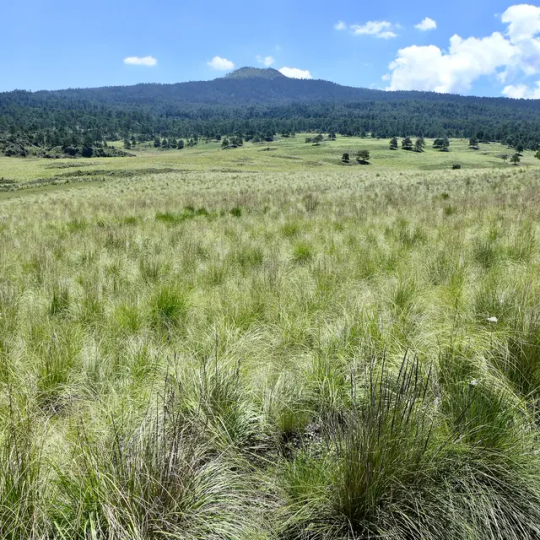
Zacaton grasslands in central Mexico, home to the Zacatuche, or volcano rabbit. Image credit: Jurgen Hoth
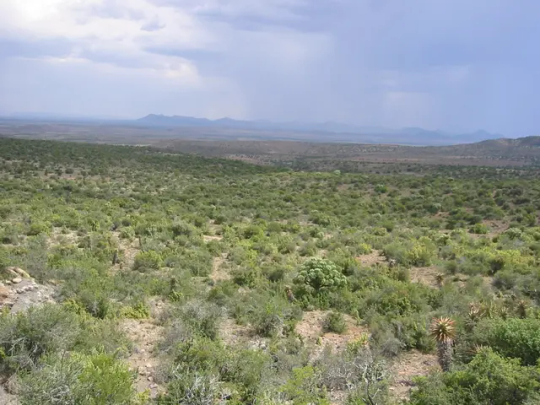
The Succulent Karoo, one of the most biodiverse ecosystems on Earth and home to the Karoo Padloper. Image credit: Tjeerd Wiersma under CC BY-SA 2.0.

The Gulf of California, home of the critically endangered Vaquita. Image credit: Natural World Heritage Sites.
663 notes
·
View notes
Text
Biden to block oil drilling across 625 million acres of U.S. waters. (Washington Post)
Excerpt from this Washington Post story:
President Joe Biden will moveMonday to block all future oil and gas drilling across more than 625 million acres of federal waters — equivalent to nearly a quarter of the total land area of the United States, according to two people briefed on the decision who spoke on the condition of anonymity because the announcement is not yet public.
The action underscores how Biden is racing to cement his legacy on climate change and conservation in his last weeks in office. President-elect Donald Trump, who has describedhis energy policy as “drill, baby, drill,” is likely to work with congressional Republicans to challenge the decision.
Biden will issue two memorandums that prohibit future federal oil and gas leasing across large swaths of the Atlantic Ocean, the Pacific Ocean, the eastern Gulf of Mexico and the Northern Bering Sea in Alaska, the two people said. The oil and gas industry has long prized the eastern Gulf of Mexico in particular, viewing the area as a key part of its offshore production plans.
The move could have the biggest impact in the Gulf of Mexico, which accounts for about 14 percent of the country’s crude oil production, according to the U.S. Energy Information Administration. Industry operations there focus on a small sliver of federal waters off Louisiana’s coast.
The decision would have little effect on a stretch of the Atlantic from North Carolina to Florida, where no drilling is underway.There is weak industry interest in the region, and lawmakers from both parties have raised concerns about possible oil spills devastating local beaches and tourism.
In fact, Trump imposed a 10-year moratorium on offshore oil exploration off the coasts of Florida, Georgia and South Carolina when courting voters there during his 2020 campaign. “This protects your beautiful gulf and your beautiful ocean, and it will for a long time to come,” Trump said as he announced the election-year reversal during an appearance at a lighthouse in Florida.
The Northern Bering Sea, off the coast of western Alaska, is home to migrating marine mammals including bowhead and beluga whales, walruses and ice seals, which are hunted by many Alaska Natives. In 2016, President Barack Obama issued an executive order that prohibited oil and gas exploration across more than 112,000 square miles of marine habitat in the Northern Bering Sea and called for tribal comanagement of the protected area.
Biden plans to invoke the 1953 Outer Continental Shelf Lands Act, which gives the president broad powers to withdraw federal waters from future leasing. A federal judge ruled in 2019 that such withdrawals cannot be undone without an act of Congress.
Sen. Mike Lee (R-Utah), the new chairman of the Senate Energy and Natural Resources Committee, suggested that he would seek to overturn the decision using the Congressional Review Act, which allows lawmakers to nullify an executive action within 60 days of enactment with a simple majority vote.
The expected move is “yet another attempt by the Biden administration to undercut the incoming Trump administration and ignore the will of the American people — who decisively voted to reverse this war on American energy,” Lee said in an emailed statement, adding, “Senate Republicans will push back using every tool at our disposal.”
154 notes
·
View notes
Text
You know what it's time for?
WEIRD SHARKS THAT'S WHAT IT'S TIME FOR
(IDs are in the image descriptions)
Pocket Shark

Pocket sharks are named for two small pocket glands appearing behind their pectoral fins. These glands are theorized to be luminous. Pocket sharks look like tiny, tiny sperm whales.
Angular Roughshark

Also called the pig-faced shark or the pig fish, angular roughsharks grow to be about 3 feet 4 in long on average. I personally think they're more bat-faced.
Goblin Shark
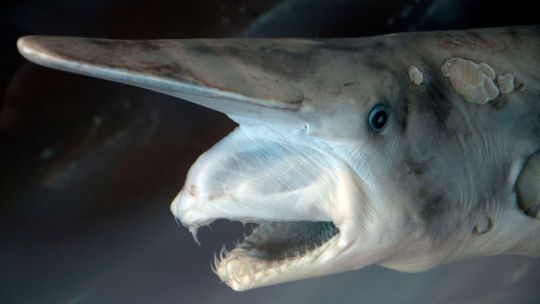
Found in the deep sea, goblin sharks are known for being able to extend their jaws like a grabber tool made of teeth. Wikipedia says that these sharks' "flabby bodies" suggest that they are sluggish in nature.
Cookiecutter Shark
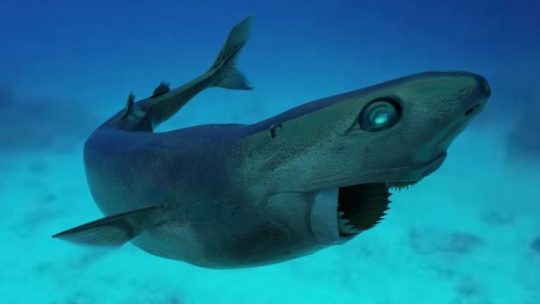
The cookiecutter shark only grows to about 20 inches in length, but that doesn't stop it from biting into orcas, great whites, or humans. It suctions onto its meal with its lips and then goes to town. It removes perfect circles of flesh, hence its name.
Wobeggong Shark
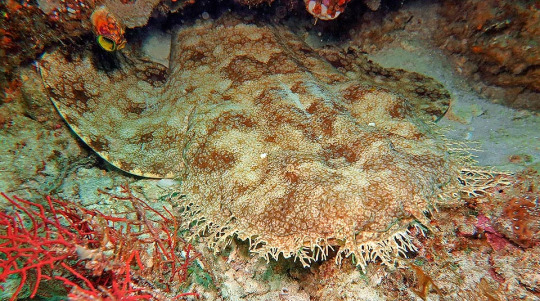
Wobeggong refers to twelve species of carpet shark, so-named for their resemblance to a shag rug. They dwell on the bottom of the sea floor and wait for smaller fish to swim nearby.
Swell Shark
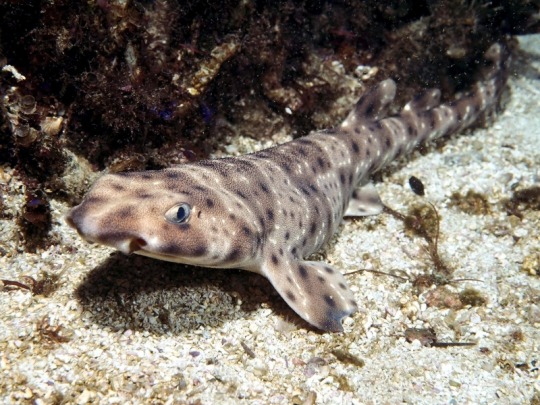
Swell sharks like to hide in crevices of algae-covered rocks, waiting for prey to swim by. They are so named not because they're really swell (though they are) but because as a defense mechanism, they can swell up to double their size by swallowing sea water.
Greenland Shark
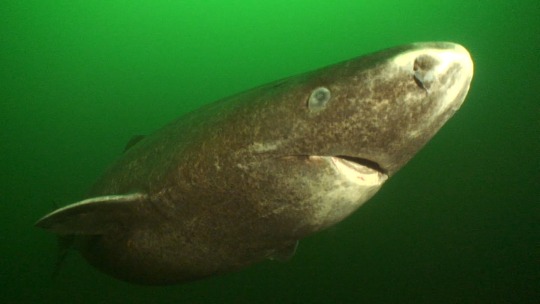
The Greenland shark has high concentrations of urea in its body. It is theorized to have a lifespan of 250 to 500 years, and it can grow up to 23 feet long. Greenland sharks have been found with moose and reindeer in their stomachs. Because of the shark's toxic levels of urea, its flesh must be fermented or otherwise treated before consumption.
Viper Dogfish
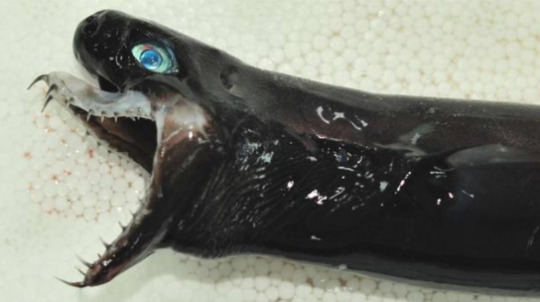
Like the goblin shark, the viper dogfish's jaws can protude from the rest of its head, though its coloring means the viper dogfish looks significantly more Xenomorphish when doing so. This small shark is a member of the lanternshark family, and its underside glows.
Pointy-Nosed Blue Chimaera
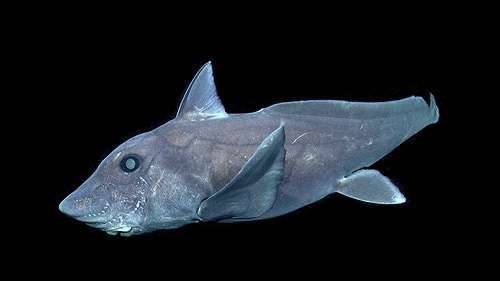
Also know as the abyssal ghostshark, this deep sea shark has a venomous spine on its dorsal fin used for defense.
Genie's Dogfish Shark
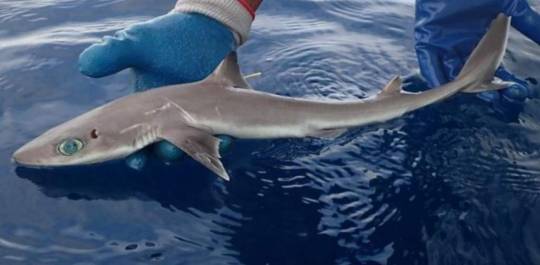
Genie's dogfish shark is a small species found in the gulf of Mexico and the west Atlantic Ocean. It has real life anime eyes.
Ninja Lanternshark
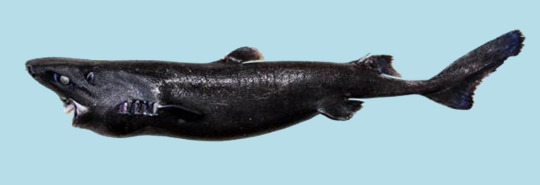
The ninja lanternshark is a small bioluminescent shark. It is all black except for white markings around its eyes and mouth. It reaches about a foot and a half in length.
Frilled Shark
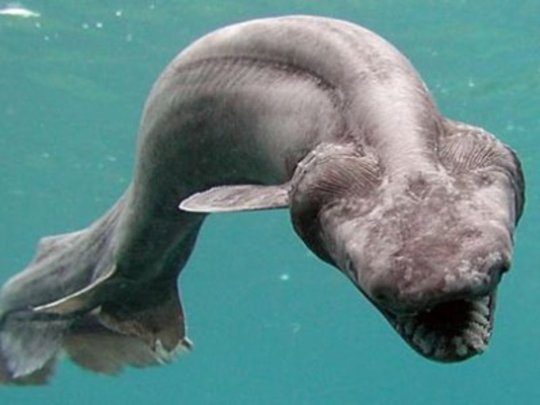
The frilled shark is sometimes called a living fossil, as it is basically unchanged in the past 80 million years. They are named for their teeth, which each have three points.
Epaulette Shark
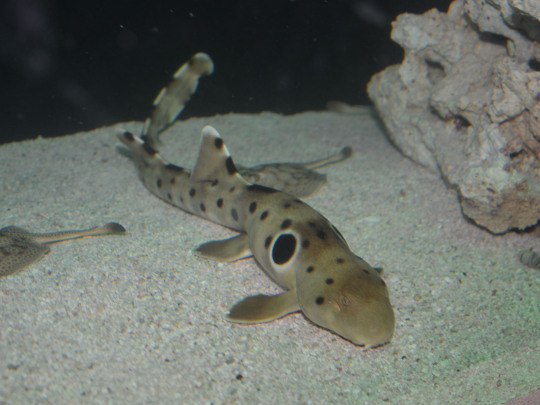
Epaulette sharks are named for the large spots behind their pectoral fins. These sharks frequently visit tidal pools and have adapted to long periods of oxygen deprivation by shutting down non-essential neural functions. Epaulette sharks often "walk" with their fins on the sea floor rather than swim.
Horn Shark
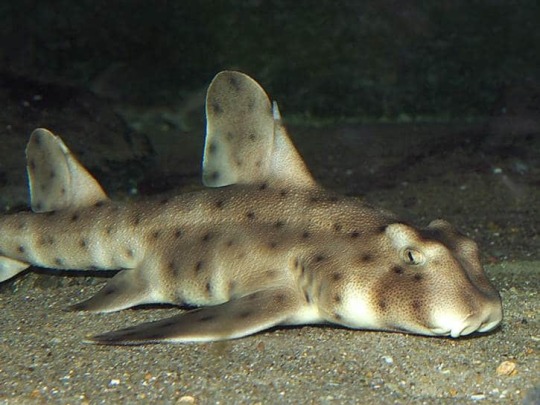
Similar to the epaulette sharks, horn sharks like to walk on the sea floor with their fins. However, these sharks have sharp spines to deter predators.
This Ridiculousness
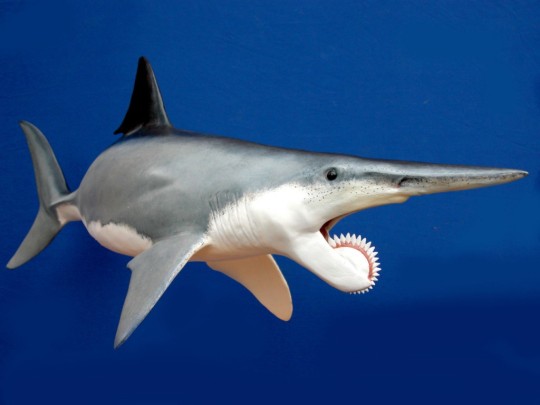
A prehistoric shark, helicoprion lived 20 million years ago and was apparently part buzzsaw. A fossil unearthed in Idaho in 2014 showed that these sharks had no teeth in their upper jaw, and a whorl of teeth in their lower jaw. It's a shame Junji Ito wasn't introduced to this shark during the writing of Uzumaki.
1K notes
·
View notes
Text
Scripps is my favorite aquarium in the world, and they have documented that the whale and dolphin populations post-Deepwater Horizon have not recovered as expected.
Sperm whale populations are down 31%. Dolphin populations are down 43%. Beaked whales, which are critically endangered, are down 83%. Fifteen years later.
The Gulf of Mexico is a critical biological environment and it has been absolutely wrecked by oil spills. The Trump administration wants more oil extraction from every possible source. They'll destroy anything they need to just to drop the gas price a few cents. You need to fight this while the species in those environments still exist, not once they're gone.
53 notes
·
View notes
Photo

Dwarf sperm whale Kogia sima
Observed by sergiomtz, CC BY-NC
#Kogia sima#dwarf sperm whale#Cetacea#Kogiidae#cetacean#whale#North America#Mexico#Baja California Sur#Pacific Ocean#Gulf of California
548 notes
·
View notes
Text
Killer whales can feed on marine mammals, turtles, and fish. In the Gulf of California, a pod might have picked up new skills that help them hunt whale sharks—the world's largest fish, growing up to 18 meters long. Whale sharks feed at aggregation sites in the Gulf of California, sometimes while they are still young and smaller. During this life-stage, they are more vulnerable to predation, and anecdotal evidence suggests orcas could be hunting them. Now, researchers in Mexico have reported four separate hunting events. "We show how orcas displayed a collaborative hunting technique on whale sharks, characterized by focusing on attacking the pelvic area causing the whale shark to bleed out and allow orcas access to the lipid-rich liver," said Erick Higuera Rivas, a marine biologist at Conexiones Terramar and senior author of the Frontiers in Marine Science article.
Continue Reading.
66 notes
·
View notes
Text
In the mountains of Transylvania, a Canadian company makes plans for a vast gold and silver mine. The proposal – which involves razing four mountain tops – sparks a national outcry, and the Romanian government pulls its support.
After protests from local communities, the Italian government bans drilling for oil within 12 miles of its shoreline. A UK fossil fuel firm has to dismantle its oilfield.
Beneath the grey whales and sea turtles of Mexico’s gulf, an underwater exploration company gets a permit to explore a huge phosphate deposit. Before it can begin, Mexico withdraws the permit, saying the ecosystem is “a natural treasure” that could be threatened by mining
Such cases appear to be part of the bread and butter of governments – updating environmental laws or responding to voter pressure. But every time, the company involved sued the government for lost profits and often, they won (Romania prevailed in its case, Italy and Mexico were forced to pay out).
They are among more than 1,400 cases analysed by the Guardian from within the investor-state dispute settlement (ISDS) system, a set of private courts in which companies can sue countries for billions. There have been long-held concerns about ISDS creating “regulatory chill” – where governments are scared off action on nature loss and the climate crisis by legal risks. Now, government ministers from a range of countries have confirmed to the Guardian that this “chilling” is already in effect – and that fear of ISDS suits is actively shaping environmental laws and regulations.
In April 2018, New Zealand banned new offshore oil exploration projects, but stopped short of an outright ban or revoking existing concession. James Shaw, who was climate minister at the time, said it was because of the risk of being sued by foreign oil and gas companies. “When we implemented the ban on offshore oil and gas exploration, we had to construct that incredibly carefully in order to avoid the risk of litigation. The way that we did that was to leave existing permits in place,” he said. As a result, New Zealand was unable to be a full member of the Beyond Oil & Gas Alliance.
Toby Landau, who has been a leading arbitration lawyer for 30 years, said acting in accordance with the Paris agreement could result in “very significant claims” for countries. He said: “It matters hugely because of the climate emergency that we are in – we’ve got an imperative under the Paris agreement to act quickly and decisively.”
The idea that this does not create a chilling effect is an “outdated and inaccurate view”. He says: “My impression from working closely with governments is that ISDS is now increasingly on their radar, that is it’s increasingly an issue for them to consider: whether implementing a particular policy might give rise to claims.
“We’re left with two regimes that conflict: the Paris agreement requires (broadly) that fossil fuels be phased out, and the ISDS regime provides guarantees for investors that protect their investment – even if it is a fossil fuel investment. That’s the conflict – it’s as simple as that.”
Rob Davies, who was minister of trade and industry of South Africa from 2009 to 2019, withdrew the country from a number of treaties with ISDS clauses from 2013 onwards. He says ISDS posed “significant risk” to the government’s legislation.
“Companies have got the right to challenge any policy … that will impact their expectation of profitability in the future, no matter what the regulation is, no matter what its motivation is, no matter how well designed it is or anything,” he says. Davies believes more recently fossil fuel companies are using the ISDS provisions to “thwart regulations on green transition”. He says: “It has a chilling effect, particularly on developing countries.”
In 2021, the International Energy Agency released a report saying the 1.5C pathway requires no new oil, gas or coal. But the issue of regulatory chill has been acknowledged by a number of international bodies, including the 2022 IPPC report on climate change. “Numerous scholars have pointed to ISDS being able to be used by fossil fuel companies to block national legislation aimed at phasing out the use of their assets,” the authors wrote. The UN, Council of Europe and European parliament have all raised similar concerns about climate action being delayed or watered down by ISDS.
“There can be astronomical costs associated with these cases,” says Kyla Tienhaara, an associate professor at the School of Environmental Studies at Queen’s University in Canada. Countries are afraid of implementing environmentally friendly policies because they can’t afford the cost of ISDS, says Tienhaara. “Governments don’t even have the funding to deal with the case in the first place.”
The Guardian investigation into ISDS reveals $84bn in payouts from governments to fossil fuel companies. More than $120bn of public money has been awarded to private investors across all industries since 1976. The average payout for a fossil fuel claim was $1.2bn.
Some cases can cost countries a significant portion of their total annual budget. For example, in 2015 Occidental Petroleum received a $1.1bn payout from the Ecuadorian government. The country’s budget was $29.8bn in 2016. Honduras faces 11 claims, with one seeking damages equal to 30% of the country’s GDP.
The problem is increasingly being discussed by climate ministers and heads of state. On the campaign trail in 2020, US presidential candidate Joe Biden said he opposed ISDS clauses in trade agreements because they allow “private corporations to attack labour, health and environmental policies”.
The Danish government set a deadline to stop fossil fuel exploration by 2050 as opposed to 2030 or 2040 because it would have had to pay “incredibly expensive” compensation to companies, on top of lost revenue for the Treasury, then-climate minister Dan Jørgensen said.
A 2023 UN report by David Boyd, the special rapporteur on human rights and the environment, found Denmark, New Zealand and France had limited their climate policies because of the threat of ISDS, with the Spanish government saying it has slowed its transition away from fossil fuels over “fear of being sued by a foreign investor”. The report stated that this threat has become a “major obstacle” for countries addressing the climate crisis.
27 notes
·
View notes
Text
So, my brother and I watched Dinosaur (2000) relatively recently, and besides the fact that it's a bad movie with horrendous character design, one thing pissed him off more than anything else: the movie's use of the word "carnotaur".
Now, to him, this word was just an infuriating attempt at saying "carnivore", which in context, makes sense. What neither he nor I knew at the time is that this is not the case. Carnotaurs are real dinosaurs. And they're really cool.
Carnotaurus sastrei, the only one of its genus, is one of the few dinosaurs we have with some of its skin preserved. We know from those preservations that it had scales, which is one of the things we assume generally about dinosaurs that we have very little evidence for. Carnotaurs also were the only known carnivorous dinosaurs with horns, which is why it's named after a bull. The other half of its name (carno-) means "meaty", and even just looking at the skeleton, you can tell that it was one THICC ASS BOI.

I'm at least 90% certain this motherfucker looked like a sausage with teeth and thighs. We all clown on the T-Rex for its tiny arms, but look at this motherfucker. We're talking whale pelvis levels of vestigial here.
Another cool thing is that geographically, the movie having these as the main hunters makes more sense than having Tyrannosaurs. T-rex lived in what is now North America, whereas these death bratwurst lived in South America. We know that the asteroid that caused the extinction of the dinosaurs landed in the Gulf of Mexico, and given that we see in the movie that very asteroid hit the earth, I don't think it takes place in what would one day become California.
All this to say, Elliot, I know more about dinosaurs than you. Suck it.
#dinosaur#dinosaurs#carnotaurus#tyrannosaurus rex#t rex#disney#movies#dinosaur movies#late cretaceous#fossils#archaeology#paleontology#posting this because i have to defend this dogshit movie somehow because god dammit it wasnt that bad in some ways#granted the writing was awful and i hated every second any character was speaking#but at least the scenery is pretty and they did their goddamn research#madam's wyrd rants
232 notes
·
View notes